We’re excited to announce Screaming Frog SEO Spider version 18.0, codenamed internally as ‘Willow’.
We’ve been busy working on one major feature we wanted to release pre to the Christmas holidays, and a variety of smaller, yet much-requested features and improvements.
Let’s take a look at what’s new in our latest update.
1) GA4 Integration
It’s taken a little while, but like most SEOs, we’ve finally come to terms that we’ll have to actually switch to GA4. You’re now able to (begrudgingly) connect to GA4 and pull in analytics data in a crawl via their new API.
Connect via ‘Config > API Access > GA4’, select from 65 available metrics, and adjust the date and dimensions.
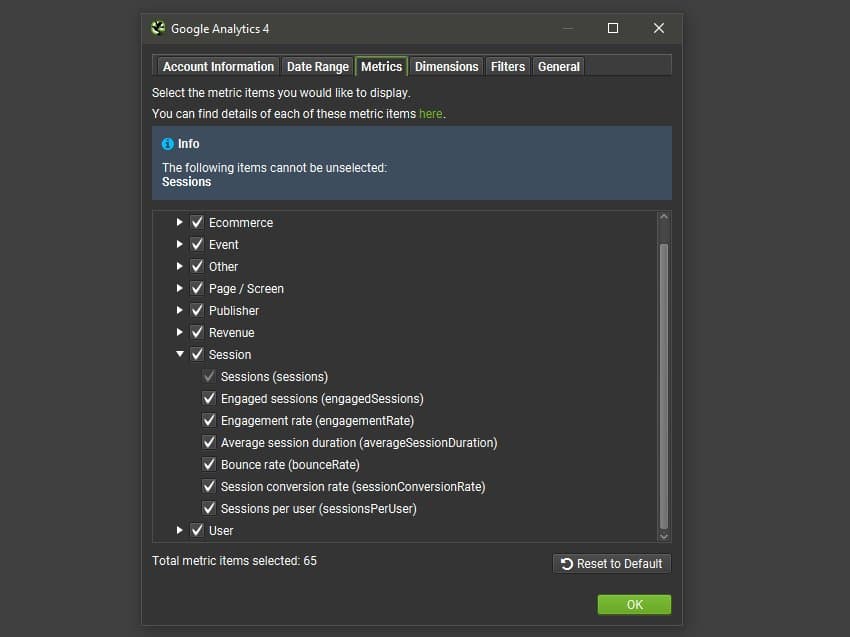
Similar to the existing UA integration, data will quickly appear under the ‘Analytics’ and Internal tabs when you start crawling in real-time.
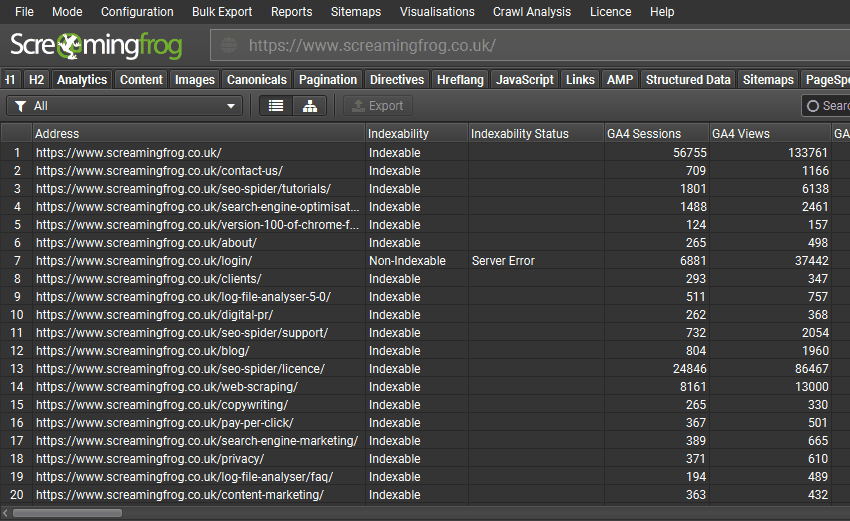
You can apply ‘filter’ dimensions like in the GA UI, including first user, or session channel grouping with dimension values, such as ‘organic search’ to refine to a specific channel.
If there are any other dimensions or filters you’d like to see supported, then do let us know.
2) Parse PDFs
PDFs are not the sexiest thing in the world, but due to the number of corporates and educational institutions that have requested this over the years, we felt compelled to provide support parsing them. The SEO Spider will now crawl PDFs, discover links within them and show the document title as the page title.
This means users can check to see whether links within PDFs are functioning as expected and issues like broken links will be reported in the usual way in the Response Codes tab. The outlinks tab will be populated, and include details such as response codes, anchor text and even what page of the PDF a link is on.
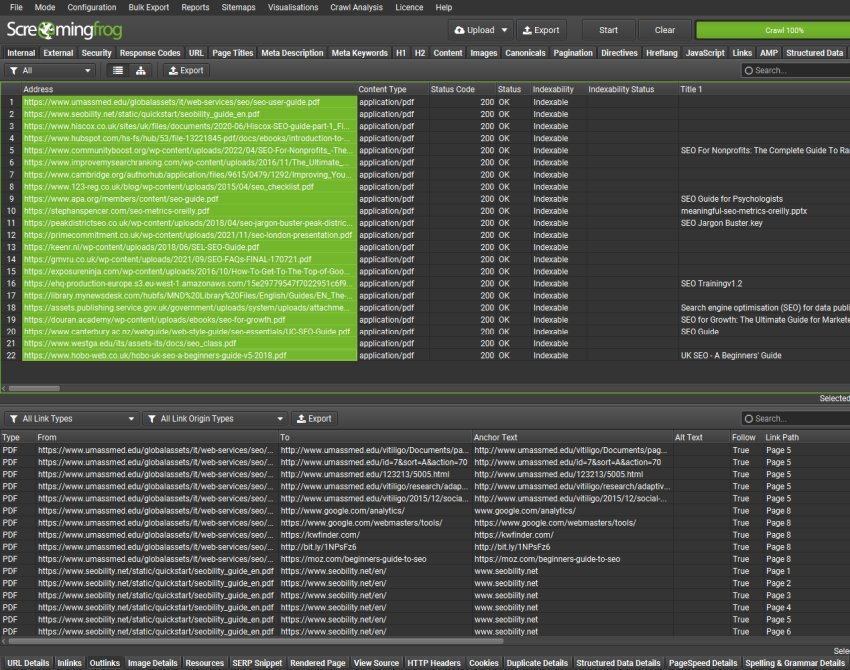
You can also choose to ‘Extract PDF Properties’ and ‘Store PDF’ under ‘Config > Spider > Extraction’ and the PDF subject, author, created and modified dates, page count and word count will be stored.
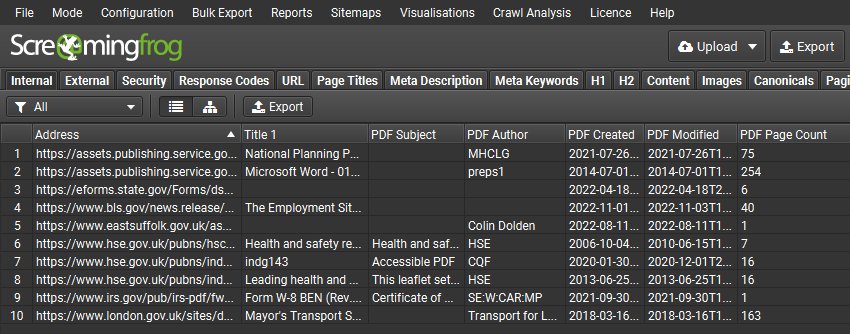
PDFs can be bulk saved and exported via ‘Bulk Export > Web > All PDF Documents’.
If you’re interested in how search engines crawl and index PDFs, check out a couple of tweets where we shared some insights from internal experiments for both Google and Bing.
3) Validation Tab
There’s a new Validation tab, which performs some basic best practice validations that can impact crawlers when crawling and indexing. This isn’t W3C HTML validation which is a little too strict, the aim of this tab is to identify issues that can impact search bots from being able to parse and understand a page reliably.
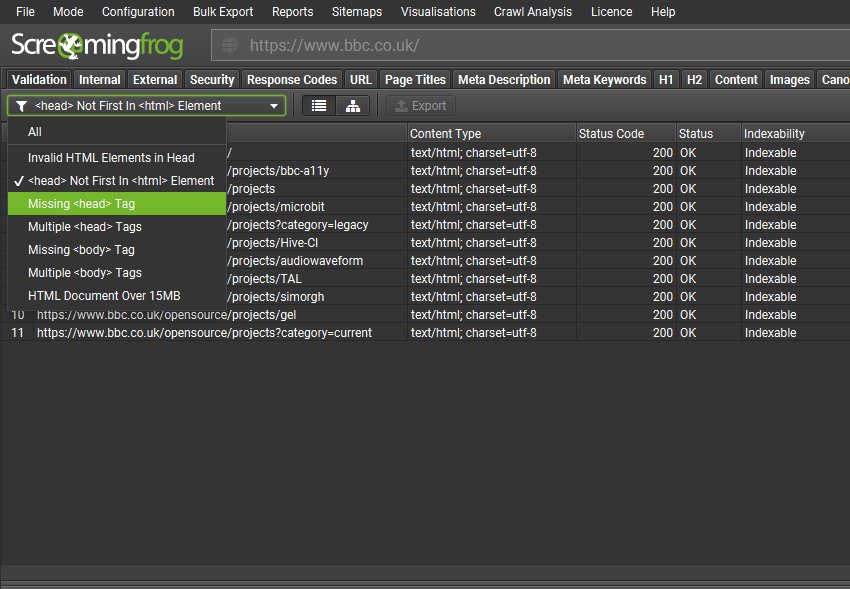
Most SEOs know about invalid HTML elements in the head causing it to close early, but there are other interesting fix-ups and quirks that both browsers like Chrome (and subsequently) Google do if it sees a non-head element prior to the head in the HTML (it creates its own blank head), or if there are multiple, or missing HTML elements etc.
The new filters include –
- Invalid HTML Elements In <head> – Pages with invalid HTML elements within the <head>. When an invalid element is used in the <head>, Google assumes the end of the <head> element and ignores any elements that appear after the invalid element. This means critical <head> elements that appear after the invalid element will not be seen. The <head> element as per the HTML standard is reserved for title, meta, link, script, style, base, noscript and template elements only.
- <head> Not First In <html> Element – Pages with an HTML element that proceed the <head> element in the HTML. The <head> should be the first element in the <html> element. Browsers and Googlebot will automatically generate a <head> element if it’s not first in the HTML. While ideally <head> elements would be in the <head>, if a valid <head> element is first in the <html> it will be considered as part of the generated <head>. However, if non <head> elements such as <p>, <body>, <img> etc are used before the intended <head> element and its metadata, then Google assumes the end of the <head> element. This means the intended <head> element and its metadata may only be seen in the <body> and ignored.
- Missing <head> Tag – Pages missing a <head> element within the HTML. The <head> element is a container for metadata about the page, that’s placed between the <html> and <body> tag. Metadata is used to define the page title, character set, styles, scripts, viewport and other data that are critical to the page. Browsers and Googlebot will automatically generate a <head> element if it’s omitted in the markup, however it may not contain meaningful metadata for the page and this should not be relied upon.
- Multiple <head> Tags – Pages with multiple <head> elements in the HTML. There should only be one <head> element in the HTML which contains all critical metadata for the document. Browsers and Googlebot will combine metadata from subsequent <head> elements if they are both before the <body>, however, this should not be relied upon and is open to potential mix-ups. Any <head> tags after the <body> starts will be ignored.
- Missing <body> Tag – Pages missing a <body> element within the HTML. The <body> element contains all the content of a page, including links, headings, paragraphs, images and more. There should be one <body> element in the HTML of the page. Browsers and Googlebot will automatically generate a <body> element if it’s omitted in the markup, however, this should not be relied upon.
- Multiple <body> Tags – Pages with multiple <body> elements in the HTML. There should only be one <body> element in the HTML which contains all content for the document. Browsers and Googlebot will try to combine content from subsequent <body> elements, however, this should not be relied upon and is open to potential mix-ups.
- HTML Document Over 15MB – Pages which are over 15MB in document size. This is important as Googlebot limit their crawling and indexing to the first 15MB of an HTML file or supported text-based file. This size does not include resources referenced in the HTML such as images, videos, CSS, and JavaScript that are fetched separately. Google only considers the first 15MB of the file for indexing and stops crawling afterwards. The file size limit is applied on the uncompressed data. The median size of an HTML file is about 30 kilobytes (KB), so pages are highly unlikely to reach this limit.
We plan on extending our validation checks and filters over time.
4) In-App Updates
Every time we release an update there will always be one or two users that remind us that they have to painstakingly visit our website, and click a button to download and install the new version.
WHY do we have to put them through this torture?
The simple answer is that historically we’ve thought it wasn’t a big deal and it’s a bit of a boring enhancement to prioritise over so many other super cool features we could build. With that said, we do listen to our users, so we went ahead and prioritised the boring-but-useful feature.
You will now be alerted in-app when there’s a new version available, which will have already silently downloaded in the background. You can then install in a few clicks.
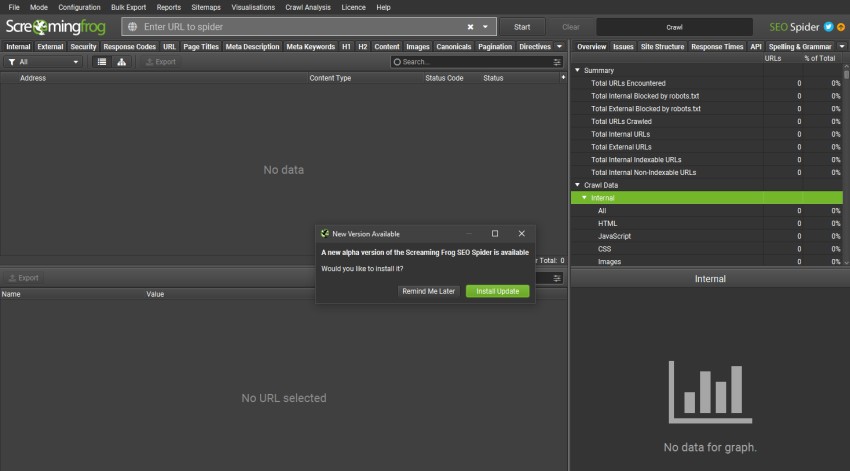
We’re planning on switching our installer, so the number of clicks required to install and auto-restart will be implemented soon, too. We can barely contain our excitement.
5) Authentication for Scheduling / CLI
Previously, the only way to authenticate via scheduling or the CLI was to supply an ‘Authorization’ HTTP header with a username and password via the HTTP header config, which worked for standards based authentication – rather than web forms.
We’ve now made this much simpler, and not just for basic or digest authentication, but web form authentication as well. In ‘Config > Authentication’, you can now provide the username and password for any standards based authentication, which will be remembered so you only need to provide it once.
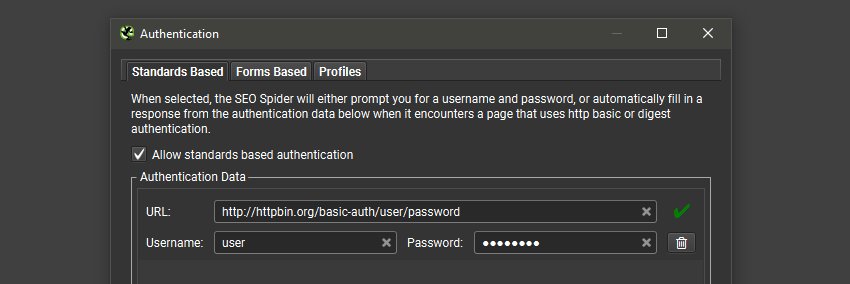
You can also login as usual via ‘Forms Based’ authentication and the cookies will be stored.
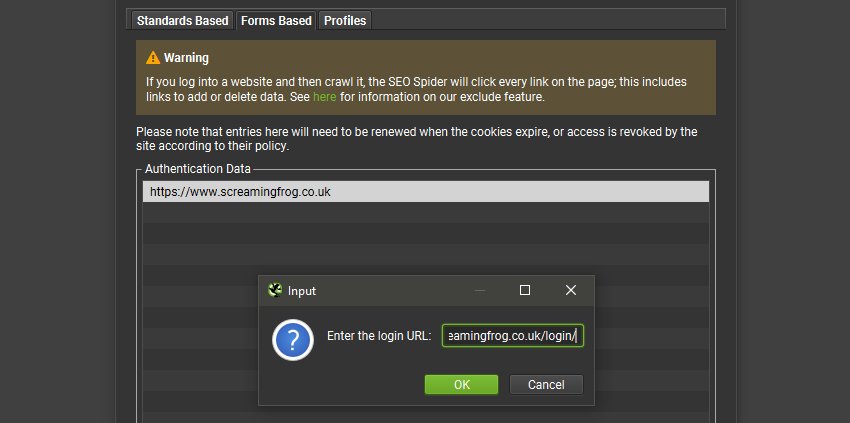
When you have provided the relevant details or logged in, you can visit the new ‘Profiles’ tab, and export a new .seospiderauthconfig file.
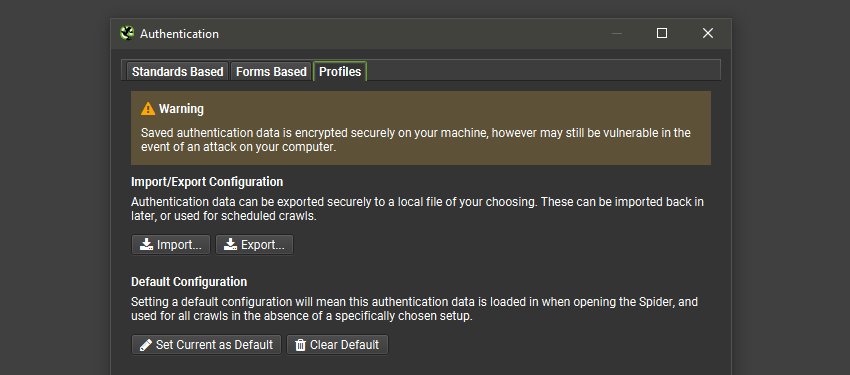
This file which has saved authentication for both standards and forms based authentication can then be supplied in scheduling, or the CLI.
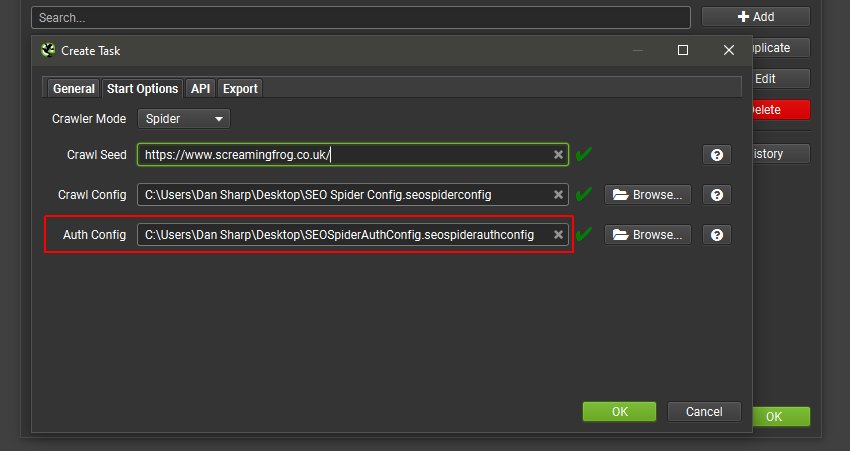
This means for scheduled or automated crawls the SEO Spider can login to not just standards based authentication, but web forms where feasible as well.
6) New Filters & Issues
There’s a variety of new filters and issues available across existing tabs that help better filter data, or communicate issues discovered.
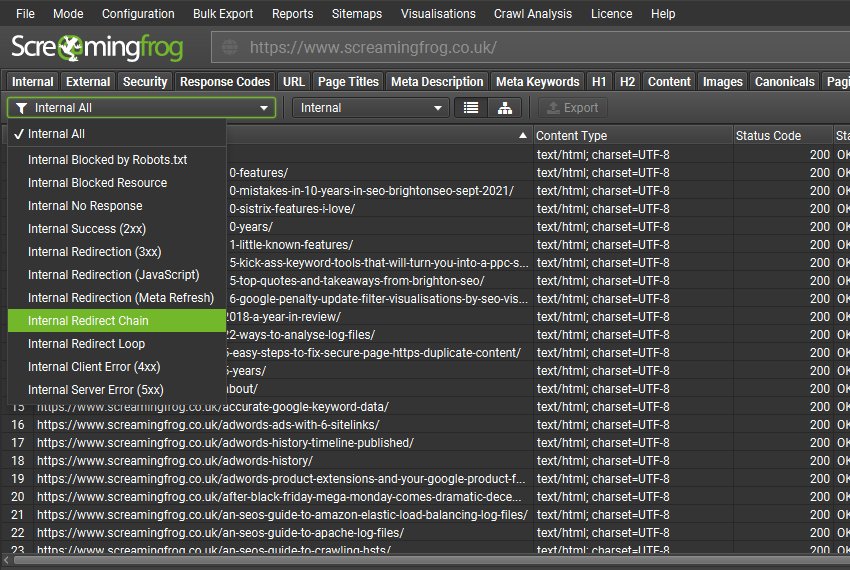
Many of these were already available either via another filter, or from an existing report like ‘Redirect Chains’. However, they now have their own dedicated filter and issue in the UI, to help raise awareness. These include –
- ‘Response Codes > Redirect Chains’ – Internal URLs that redirect to another URL, which also then redirects. This can occur multiple times in a row, each redirect is referred to as a ‘hop’. Full redirect chains can be viewed and exported via ‘Reports > Redirects > Redirect Chains’.
- ‘Response Codes > Redirect Loop’ – Internal URLs that redirect to another URL, which also then redirects. This can occur multiple times in a row, each redirect is referred to as a ‘hop’. This filter will only populate if a URL redirects to a previous URL within the redirect chain. Redirect chains with a loop can be viewed and exported via ‘Reports > Redirects > Redirect Chains’ with the ‘Loop’ column filtered to ‘True’.
- ‘Images > Background Images’ – CSS background and dynamically loaded images discovered across the website, which should be used for non-critical and decorative purposes. Background images are not typically indexed by Google and browsers do not provide alt attributes or text on background images to assistive technology.
- ‘Canonicals > Multiple Conflicting’ – Pages with multiple canonicals set for a URL that have different URLs specified (via either multiple link elements, HTTP header, or both combined). This can lead to unpredictability, as there should only be a single canonical URL set by a single implementation (link element, or HTTP header) for a page.
- ‘Canonicals > Canonical Is Relative’ – Pages that have a relative rather than absolute rel=”canonical” link tag. While the tag, like many HTML tags, accepts both relative and absolute URLs, it’s easy to make subtle mistakes with relative paths that could cause indexing-related issues.
- ‘Canonicals > Unlinked’ – URLs that are only discoverable via rel=”canonical” and are not linked-to via hyperlinks on the website. This might be a sign of a problem with internal linking, or the URLs contained in the canonical.
- ‘Links > Non-Indexable Page Inlinks Only’ – Indexable pages that are only linked-to from pages that are non-indexable, which includes noindex, canonicalised or robots.txt disallowed pages. Pages with noindex and links from them will initially be crawled, but noindex pages will be removed from the index and be crawled less over time. Links from these pages may also be crawled less and it has been debated by Googlers whether links will continue to be counted at all. Links from canonicalised pages can be crawled initially, but PageRank may not flow as expected if indexing and link signals are passed to another page as indicated in the canonical. This may impact discovery and ranking. Robots.txt pages can’t be crawled, so links from these pages will not be seen.
7) Flesch Readability Scores
Flesch readability scores are now calculated and included within the ‘Content‘ tab with new filters for ‘Readability Difficult’ and Readability Very Difficult’.
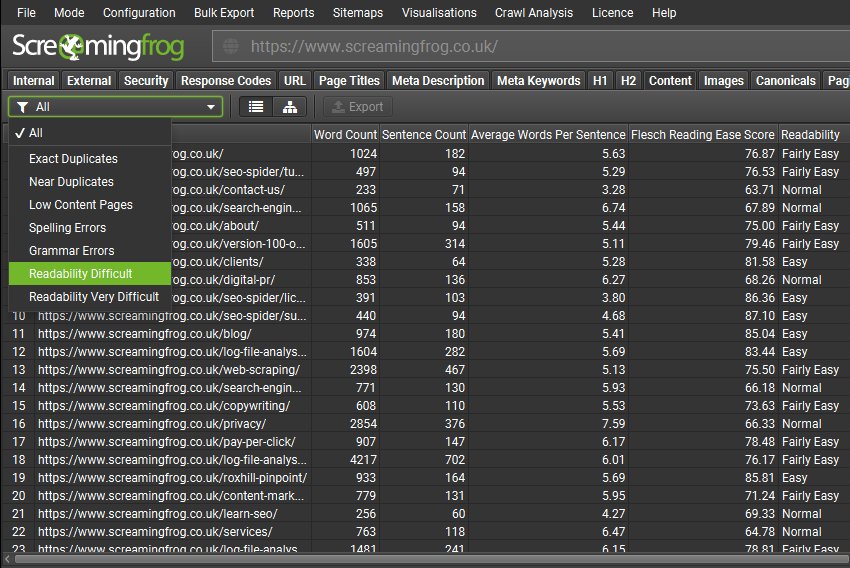
Please note, the readability scores are suited for English language, and we may provide support to additional languages or alternative readability scores for other languages in the future.
Readability scores can be disabled under ‘Config > Spider > Extraction’.
Other Updates
Auto Complete URL Bar
The URL bar will now show suggested URLs to enter as you type based upon previous URL bar history, which a user can quickly select to help save precious seconds.

Response Code Colours for Visualisations
You’re now able to select to ‘Use Response Code Node Colours’ in crawl visualisations.
This means nodes for no responses, 2XX, 3XX, 4XX and 5XX buckets will be coloured individually, to help users spot issues related to responses more effectively.
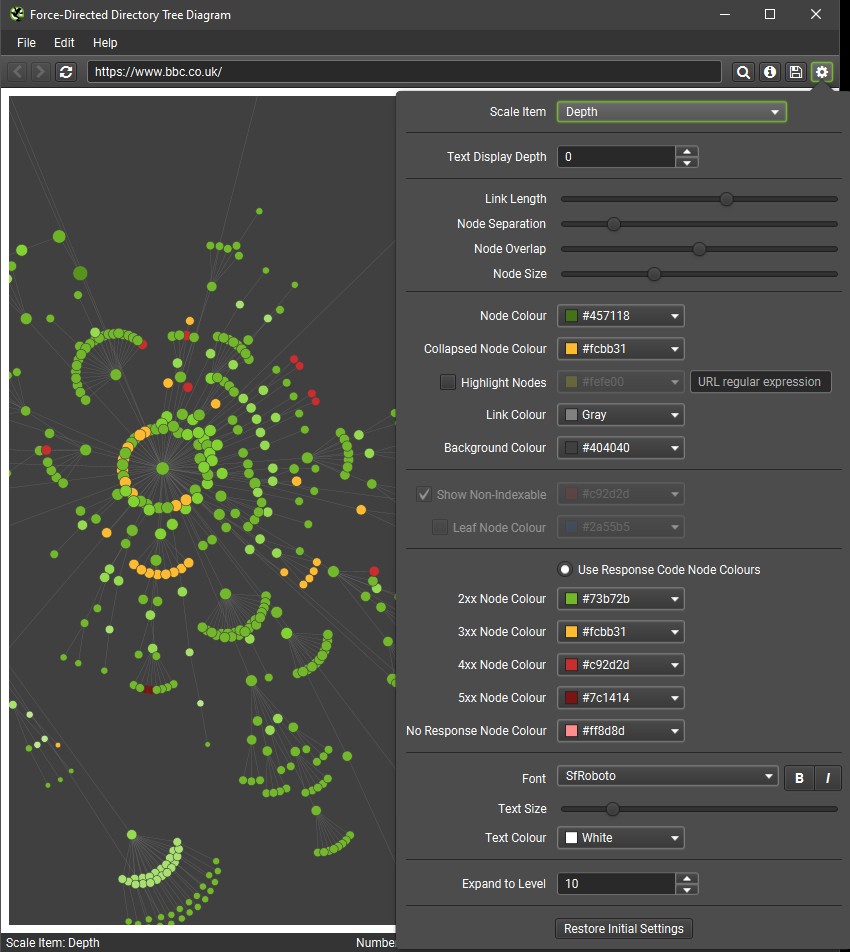
XML Sitemap Source In Scheduling
You can now choose an XML Sitemap URL as the source in scheduling and via the CL in list mode like the regular UI.
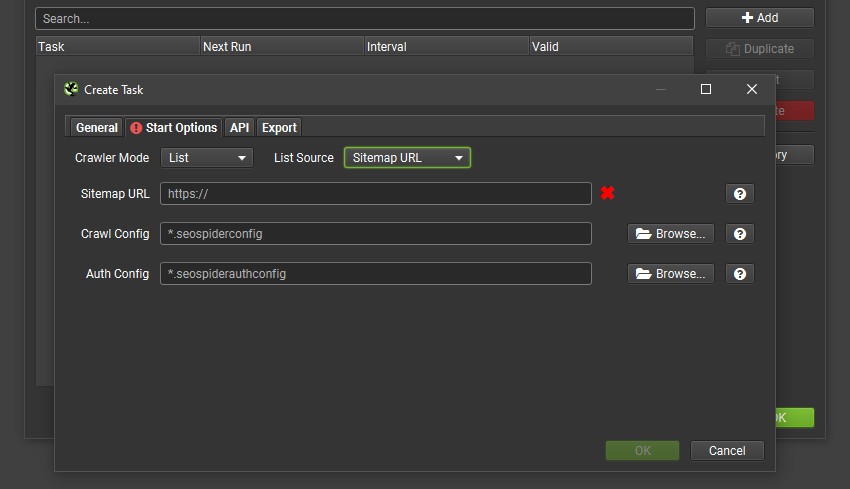
Version 18.0 also includes a number of smaller updates and bug fixes.
- 3 million Google rich result feature updates for structured data validation.
- The Apache-Common-Text file has been updated > 1.10.0 for vulnerability CVE-2022-42889.
Thanks again to everyone for their continued support, feature requests and feedback. Please let us know if you experience any issues with version 18.0 of the SEO Spider via our support.
Small Update – Version 18.1 Released 14th December 2022
We have just released a small update to version 18.1 of the SEO Spider. This release is mainly bug fixes and small improvements –
- Added Education QA & Audit Google features.
- Add support for video/mp4 mimetype.
- SERP exports now import and export in users langauge.
- Index out of bounds shown for URLs with invalid php tags.
- Fix issue with JavaScript Rendering on Fedora triggering keyring dialog.
- Fix issue with some exported PDFs not opening.
- Fix ::before being shown in headings.
- Fix various crashes, including PDFs links with spaces and newlines, auto saving of config and more.
Small Update – Version 18.2 Released 13th February 2023
We have just released a small update to version 18.2 of the SEO Spider. This release is mainly bug fixes and small improvements –
- Add quotas to GA4 UI.
- Renable spell check for Apple Silicon macs for some languages that were previously disabled.
- Allow scheduled crawls to run forever and run on battery.
- Update structured data with recent smaller changes to standard.
- Fix GA4 issues with not retriving more than 10k results.
- Fix issue exporting to Google Sheets when overwriting and the sheet has been removed/replaced.
- Fix various issues with HTML validation.
- Fix font issues affecting some customers on Windows.
- Fix occasional issue with connecting to Google Services.
- Fix PDF link extraction only use absolute URLs.
- Fix URL encoding issue preventing some pages loading in JavaScript rendering.
- Fix issues with blank cells in Excel not being regarded as black by the ISBLANK funtion.
- Fix broken icon in ‘Spider > Configuration > Advanced’.
- Fix missing translations for all languages.
- Fix issue with sorting readability column.
- Fix issue with exporting issues reports.
- Fix parsing issues caused by pseduo-elements.
- Fix crash / pop up of developer tools dialog connecting to GA4 on macOS.
- Fix crash sorting scheduler UI.

Leave a Reply